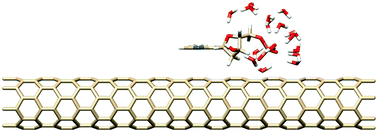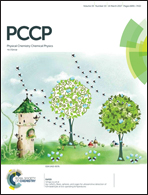Electronic properties of carbon nanotubes complexed with a DNA nucleotide†
Abstract
Electronic properties of carbon nanotubes (CNTs) play an important role in their interactions with nano-structured materials. In this work, interactions of adenosine monophosphate (AMP), a DNA nucleotide, with metallic and semi-conducting CNTs are studied using the density functional tight binding (DFTB) method. The electronic structure of semi-conducting CNTs was found to be changed as they turned to metallic CNTs in a vacuum upon interaction with the nucleotide while metallic CNTs remain metallic. Specifically, the band gap of semi-conducting CNTs was decreased by 0.79 eV on average while nearly no change was found in the metallic tubes. However, our investigations showed that the presence of explicit water molecules prevents the metallicity change and only small changes in the CNT band gap occur. According to our charge analysis, the average negative charge accumulated on CNTs upon interaction with the AMP was determined to be 0.77 e in a vacuum while it was 0.03 e in solution. Therefore, it is essential to include explicit water molecules in simulating complexes formed by DNA nucleotides and CNTs which were ignored in several past studies performed using quantum mechanical approaches.



 Please wait while we load your content...
Please wait while we load your content...